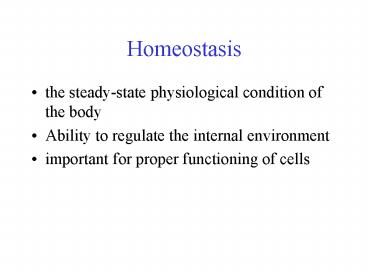Homeostasis - PowerPoint PPT Presentation
1 / 46
Title:
Homeostasis
Description:
Homeostasis the steady-state physiological condition of the body Ability to regulate the internal environment important for proper functioning of cells – PowerPoint PPT presentation
Number of Views:270
Avg rating:3.0/5.0
Title: Homeostasis
1
Homeostasis
- the steady-state physiological condition of the
body - Ability to regulate the internal environment
- important for proper functioning of cells
2
Homeostasis
- Thermoregulation
- how organisms regulate their body temperature
- Osmoregulation
- how organisms regulate solute balance and gain or
loss of water - Excretion
- how organisms get rid of nitrogen-containing
waste products of metabolism, such as urea
3
Homeostasis
- Maintenance usually involves negative feedback
loops
4
(No Transcript)
5
Feedback mechanisms in human thermoregulation
6
Figure 44.4 The relationship between body
temperature and ambient (environmental)
temperature in an ectotherm and an endotherm
7
Figure 44.5 Countercurrent heat exchangers
8
Excretion
- Nitrogen-containing wastes from the metabolism of
proteins and nucleic acids are particularly bad. - the nitrogenous waste product is ammonia (NH3)
9
Ammonia
- most efficient to excrete directly
- Very toxic, soluble in water
- must be excreted in dilute solutions
- Excreted by most aquatic organisms
- diffuses across body surface or gills
10
Terrestrial animals
- Cant afford to lose a lot of water
- excrete substances that can be excreted in more
concentrated form - use energy to convert ammonia to a less toxic
molecule - urea or uric acid
11
Urea
- Much less toxic
- excreted by many terrestrial animals
- produced in liver
- metabolic cycle combines ammonia carbon dioxide
12
Figure 44.13 Nitrogenous wastes
13
Uric Acid
- Excreted by some land snails, insects, birds
reptiles - Not soluble in water
- excreted as a precipitate after water has been
reabsorbed
14
Urea vs Uric Acid
- Both adaptations to conserve water
- depends on mode of reproduction
- animals with shelled eggs excrete uric acid
15
Osmoregulation
- Cells cannot survive a net gain or loss of water
- common problem to all animals
- solutions differ
16
Osmoregulation
- Two basic solutions
- Be isotonic to the environment
- osmoconformers
- Actively discharge (in hypotonic environments) or
take in ( in hypertonic environments) water - osmoregulators
17
Marine Environments
- Most marine invertebrates are osmoconformers
- may still regulate specific ion concentrations
- Most marine vertebrates osmoregulate
- Chondrichthyes
- isotonic but lower salt conc. high urea conc.
- Osteichthyes
- hypotonic to environment
18
Osmoregulation in a saltwater fish
19
Figure 44.12 Salt-excreting glands in birds
20
Freshwater Environments
- Problem of water entering body via osmosis
- Protozoa (amoeba paramecium)
- use contractile vacuoles
21
(No Transcript)
22
Freshwater Environments
- Freshwater Bony Fish
23
Osmoregulation in a freshwater fish
24
Terrestrial Environments
- Many adaptations to prevent water loss
- shells, layers of dead skin, waxy cuticle,
exoskeletons, scales, etc. - Drink water eat moist foods
- Specialized organs to conserve water
- ex kidneys
25
The human excretory system
26
Mammalian Excretory System
- renal artery and renal vein
- Urine exits the kidneys through the ureter
- The ureters of both kidneys enter the urinary
bladder - Urine leaves the body via the urethra
- Sphincter muscles between the bladder and urethra
control urination
27
The human kidney
28
Kidney
- outer renal cortex inner renal medulla
- within each region are microscopic excretory
tubules called nephrons, collecting ducts and
capillaries - the nephron is the functional unit of the kidney
- renal pelvis
29
The nephron within the human kidney
30
The nephron and collecting duct
31
Function of Nephron
- 1. Filtration of blood
- blood pressure forces any small molecules from
the blood into the lumen in the bowmans capsule - a nonselective process with regard to small
molecules - filtrate initially consists of water, urea,
salts, glucose, vitamins, etc.
32
Function of Nephron
- 2. Secretion
- substances are transported into the filtrate
- most commonly occurs in the proximal and distal
tubules - a very selective process involving both passive
and active transport
33
Function of Nephron
- 3. Reabsorption
- the selective transport from the filtrate to the
interstitial fluid or blood plasma - Sugars, vitamins, organic nutrients and water are
all reabsorbed
34
Figure 44.22 The nephron and collecting duct
regional functions of the transport epithelium
35
Function of Nephron
- 4. Excretion
- Get rid of the wastes
36
Key functions of the nephron
37
Figure 44.23 How the human kidney concentrates
urine the two-solute model (Layer 1)
38
Figure 44.23 How the human kidney concentrates
urine the two-solute model (Layer 2)
39
Figure 44.23 How the human kidney concentrates
urine the two-solute model (Layer 3)
40
(No Transcript)
41
Characteristics of Urine
- The kidneys can produce a hypertonic urine when
it is necessary - can excrete a hypotonic urine
- Water and salt reabsorption are subject to
nervous and hormonal control
42
ADH (Antidiuretic Hormone)
- released when the solute concentration of the
blood rises - makes the transport epithelium of the distal
tubules and the collecting ducts more permeable
to water - alcohol inhibits production of ADH
43
Hormonal control of the kidney by negative
feedback circuits
44
Evolution of the Vertebrate Kidney
- 1st in freshwater fish
- Fish, amphibian reptile kidneys can only
produce urine that is isotonic or hypotonic to
their body fluids - Terrestrial reptiles can reabsorb water in
cloaca
45
Evolution of the Vertebrate Kidney
- Only birds and mammals have loops of Henle in
their nephrons - Hypertonic urine
- Mammals have more juxtamedullary nephrons than
birds
46
(No Transcript)

